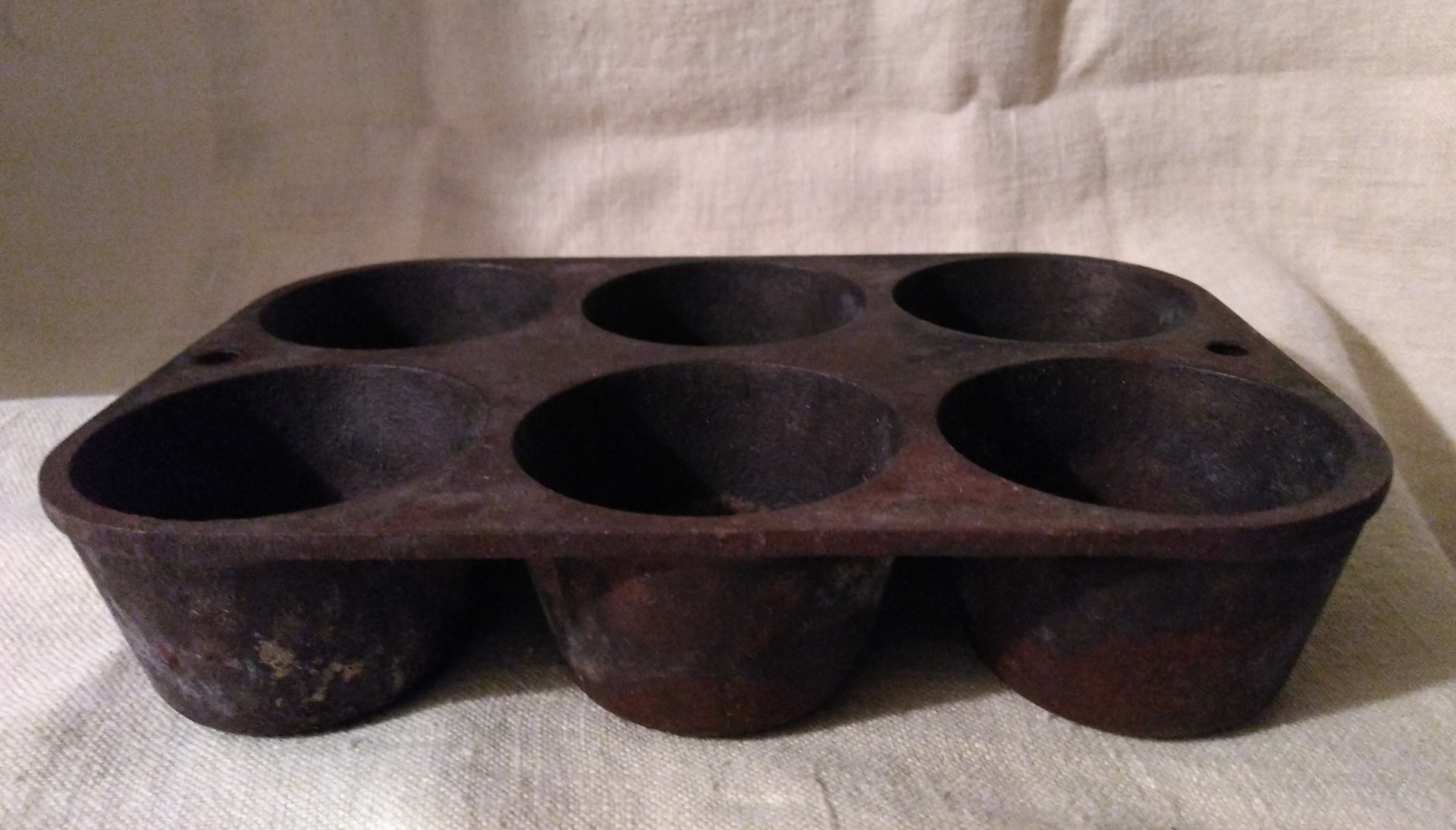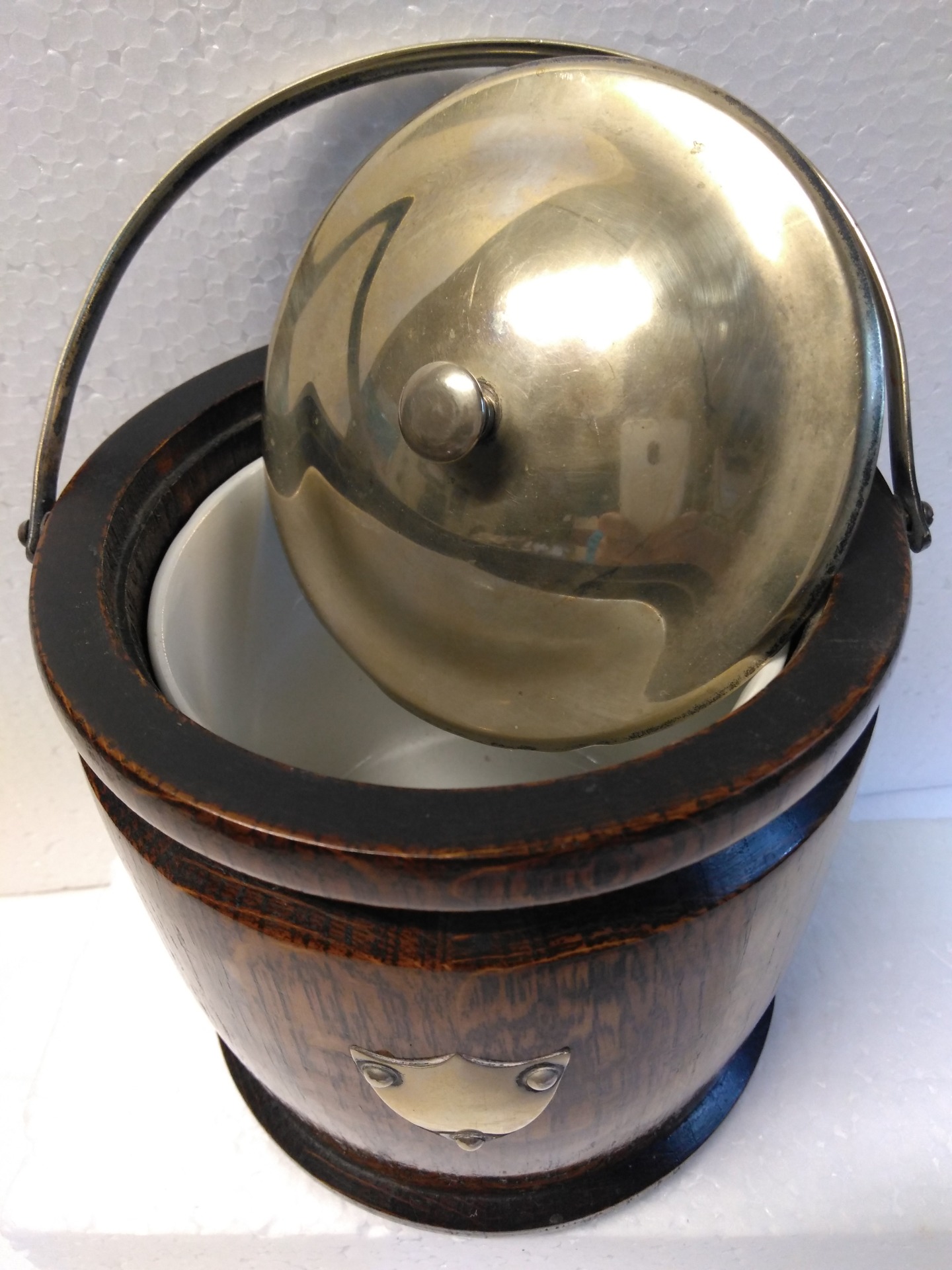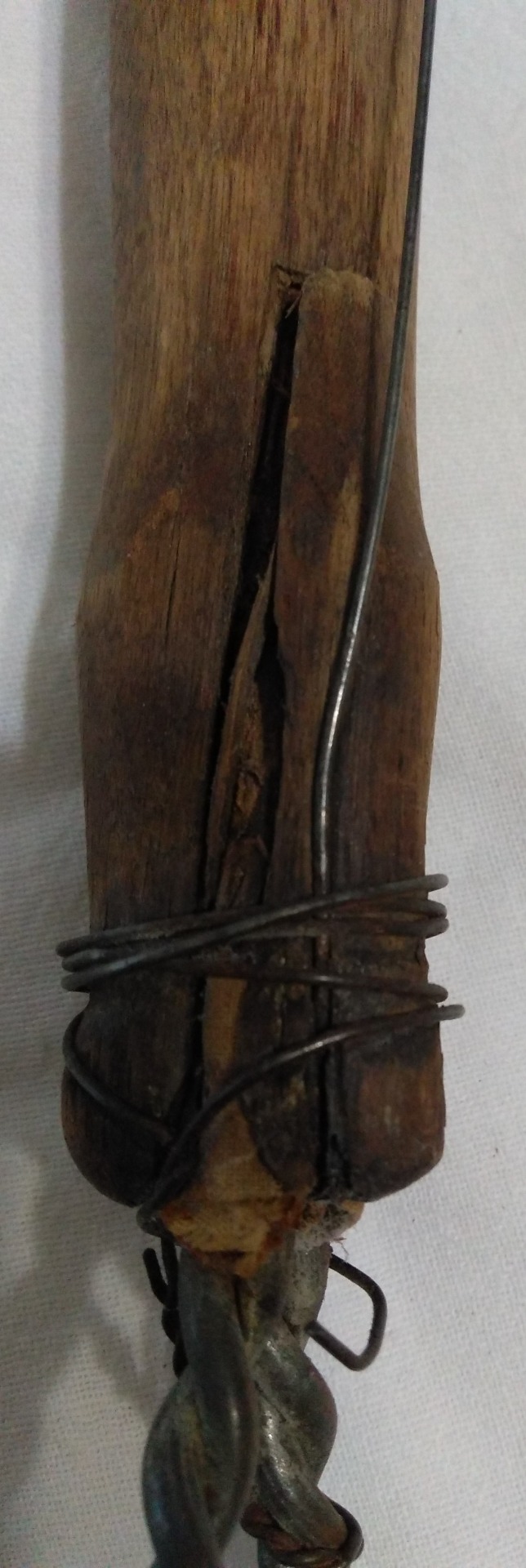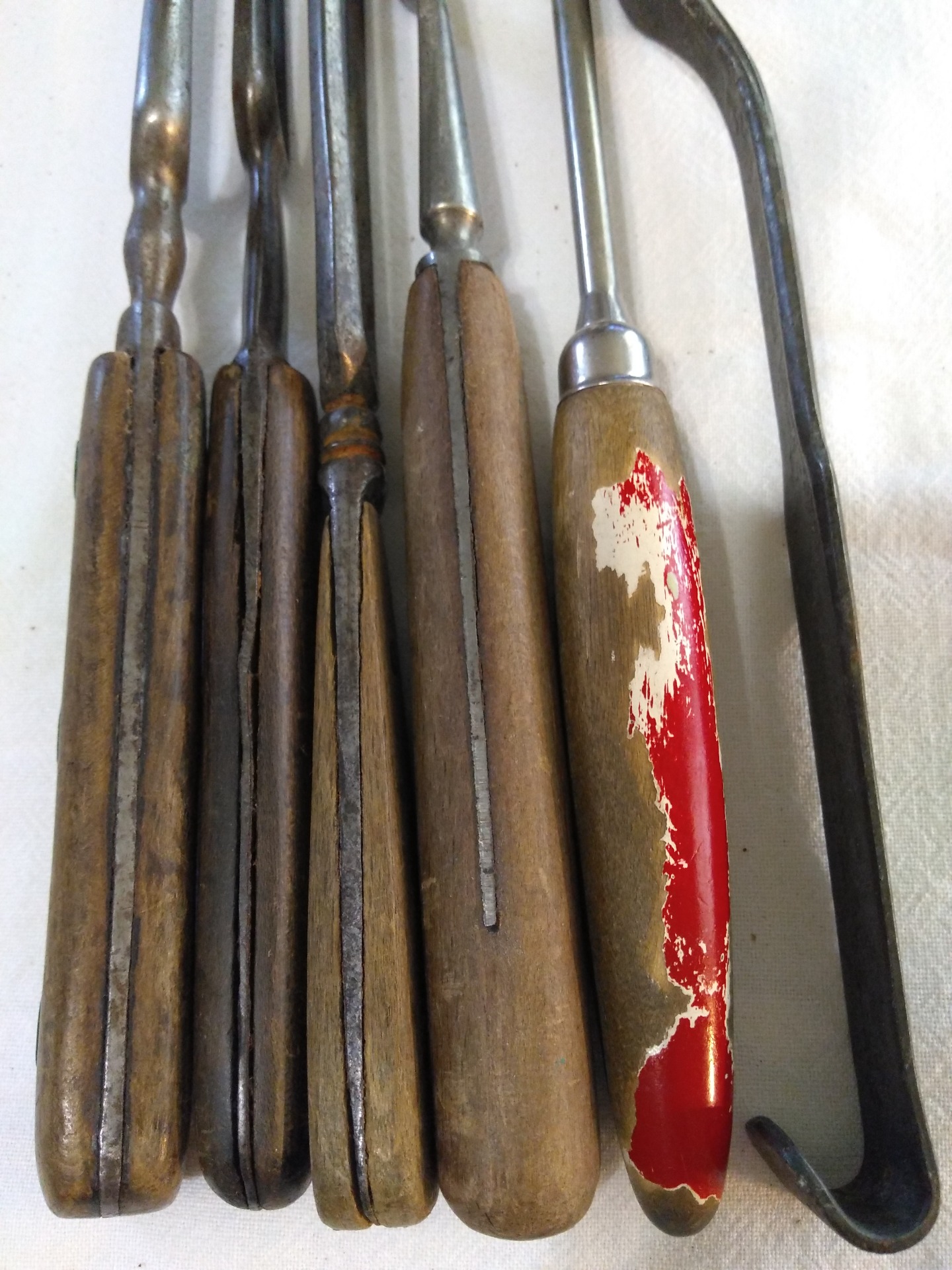
HOME BAKING ARTIFACTS
Preserving baking-related artifacts of the past, is a way to honor and pay tribute to our moms and generations of grandmothers who created the Heart of the Home through their baking and raising families. Supporting the dads in the fields and mills was a time-honored tradition by using the grains that brought greatness to this land, heritage recipes, baking aromas, and love.
~ Welcome! ~
In speaking about the creation of the National Bread Museum (NBM) for the United States, people generally have no concept of the contents of such a project. ( At breadculture.net you can click on "Bread Museum Database" to get an idea of those around the world, & download the Atlas - Bread Museums in Europe & Beyond.) The vision for this museum is for education and personal enjoyment through the preservation of historical-to-some-current artifacts associated with the subject of "bread culture" which primarily covers the theme of Ag/Grain - Milling - Flour - Bread/Baking.
The artifact emphasis is especially on "home baking" to pay tribute to the women who carved out a career in the home while baking to feed the family. It is also a tribute to the men and women who developed the food-grain agricultural foundation upon which this country was built, and the subsequent home town bakers who filled a niche in local communities. The bottom line is "baking" and almost all of it "from scratch" . . . healthy & hearty. And we never want "fading memories" and to forget that it all began in the home, mostly with Mom 😊.
The artifacts exhibited in this section represent a few of the thousands of artifacts available (primarily 1850-1999) to establish the museum complex to tell of and preserve our nation's and peoples' bread culture history and heritage. The following books are the kinds of resources to help those who have that curious nature and want to know how people "know this stuff!" These books also help to pass on the history of your ancestors' way of life. And who knows, what goes around may come around, and some day survival might depend on much "make-do" know-how, such as "repairing to keep on using" until the item becomes shreds, or war or death departs. Remember, every artifact represents someone's loving hands and life.








A Note of Interest: As the NBM founder, I lived in Germany 1988-91 (right after 6 years in England). Following the fall of the Berlin Wall in Nov. 1989, many market vendors gleaned tons of flohmarkt items from the former East German & other "behind The Wall," also known as "behind The Iron Curtain," countries. This became my source for many of the "old world" grain-related and kitchenalia artifacts of our European ancestors, used from the latter 1800s onward through WWII, and probably during much of the Iron Curtain communist era. Many kitchenalia and household items I gleaned in the flohmarkts had also been imported into the USA beginning in the late 1800s, but most I have never seen during my life here in the U.S., or in antique malls during the past 30+ years. The Industrial Revolution also spawned American manufacturers into much kitchenalia manufacturing. The best resources are Linda Campbell Franklin's two books, 300 Years of Kitchen Collectibles [several editions] & her
300 Years of Housekeeping Collectibles.






Now today, you might have some treasured heritage, baking-related artifacts which you would like to have preserved for the historical record of your family & this country. If the younger people of your family don't want to "keep" just for the sake of keeping, & you believe a contribution to the historical preservation is of higher value than some money you'd get by selling, please consider this museum/project for its new home. (It's another reason we need to get an "on the land" museum going asap!)
Email me at breadmuseum@aol.com -- Donna Kozak, Founder
A variety of the following were essentials in Grandma's house in the USA in the 18-1900s. Similarities used today are many times of a "modern" version made with plastic, a "rubberized-type" substance, and/or various other materials. Those not used today reflect changes in the American life style. Still, many basic designs of one sort or another continue to be found in the working hands of lives around the world today. Just remember, if you get to have & to hold a treasure of the past, each historical artifact is an unwritten diary of someone's life.
1. APPLIANCE COMPANIES


2. BAKING PANS, MOLDS, FORMS ++ (sizes in inches are rounded to the nearest fourth (.25) or half (.5).)












3. BASKETS




4. BREAD BOXES, KEEPERS, Storage CONTAINERS; Bread & Grain-related BAGS for foods to eat




5. BREADS, EDIBLE - forms of, kinds; COMMERCIAL bakeries & companies



6. BOARDS of all sorts

7. BOWLS

One of the non-edible "Basic Dough Recipes" for something like the Bread Dough Bowl above would be:
#1 - 4 cups flour & 2 cups table salt - (Mix in a mixing bowl.)
#2 - 1½ to 1¾ cups cold water - (Add. Mix well with hands. Knead till smooth, about 10-15 minutes. Cover with plastic wrap or keep in a plastic bag. It's best to use within a few hours.)
#3 - Place your item(s) on a lightly greased cookie sheet. If making hanging ornaments, etc., have any holes for attaching ribbon or string made before baking, or insert a hair pin as a hanger (may need to cut off some of the length); etc., etc.
#4 - Bake in a preheated 325 degrees F. oven for an hour (checking every so often); air-dry for a day or so to be rock hard. If it begins to brown more than your desired color, remove & air-dry for several days.
#5 - Can acrylic paint; can attach separate pieces with glue & let dry overnight; can coat with 4 layers of a floor finish or other choice substance for a clear finish. (from a Johnson's Wax handcraft brochure, 1970's era)
#6 - To use for serving, use a liner.
*Note: The last photo section at the end of this page has a few additional handcraft, "Bread Dough," decorative items.
8. · BUTTER CHURNS, MOLDS, STAMPS ++
9. CAKE & related bakery



























There are a lot of tube pans, but there's a difference for most because of their intended purpose; although, many can also be used interchangeably. Above: four similar cake pans (or for specific breads) - a baker should know the difference of each. The 1st 3 are called "tube pans," the middle two specifically "angel food cake pans with the removeable center. #1 tin, #2 aluminum, each with 3 "leg" tabs (on some pans the tabs turn to the side for storage purposes). #3 has a "non-stick" surface. Angel food cakes generally rise above the edge of the pan; therefore, the need for the "legs." You must turn the cake upside down for the cooling time, so if there are no "legs" (#3), you still must cool it, upside down. The tube might be taller than the height of the pan, and if the cake top doesn't touch the counter, you can just turn the pan over - resting on the tube. But otherwise, the tradition is to set the tube over the top of a wine or other thin-necked bottle (something that the tube's hole fits over). If it's an empty bottle and you're concerned about the top-heavy weight with the cake, you'd fill the bottle with water for heft. #4 a "spring-form" pan (w/a side clip for loosening/tightening) for various cakes or breads to have a decorative top.
CAKE UTENSILS: All the following utensils were for making cake & similar "loose" batters. Egg Whisks & Whips were different than Egg Beaters! There's a difference among stirring, whipping, beating, blending, folding, mixing "just until . . .," etc. :)








# 2) above left & the handle to the left: "Swans Down Cake Flour" . . . probably a "premium give-away" or a company offer to get with company coupons on the cake flour bag




Above & on the right are BATTER BEATERS, & the 2 on the right were also known as EGG WHIPS.



Whisks & Whips. The handle of the center whisk, above, is below: a wrapped string/cord handle.







This grouping is EGG WHIPS or EGG WHISKS - patents from 1890s to 1927. Some variations might still be made, altho generally the common ballooned-shaped WIRE WHISK (not shown) is preferred by most today.
If you have to use an egg whisk to beat egg whites stiff, lower left, the workout is tremendous!! It seems to take forever! To me, the others would even be worse! Thank the Lord for electric mixer beaters today!


10. CELEBRATIONS - TRADITIONS - EVENTS - HOLIDAYS


11. CLOTH - APRONS, TOWELS, HOT PADS, OVEN MITTS ++












A NOTE OF INTEREST REGARDING WEDDINGS "BACK IN THE DAY" - & related to the apron above at least through the 1970s. The following still goes on today in the small-towns, rural communities, & with some church communities even in the large metropolitan areas. Weddings never used to cost thousands of dollars for a hall, catering, etc. In a community, almost everyone belonged to a local church. All the women belonged to the Ladies Aid Society or other-named "women's group" which maybe met once a month. If you lived "out on the farm," this association with the other women in the area was invaluable.
These women carried out the social functions of the parishioners & sometimes their community. There was a hall (a big community room), attached or in the lower level of the church, with a kitchen, long tables, & chairs. For all weddings & funerals of families in the church, women would volunteer when they could, but almost all provided a dish for each event. For our wedding, we paid for the ham & one other meat, plus the wedding cake. All the rest was donated . . . like a pot luck, for at least 150 people. And there was so much food left over that it fed around 40 people at the house for supper, & everyone who came back at midnight after the dance . . . & I imagine for the family for some time after we left. (P.S. All the out-of-pocket expenses were a bit over $400 for our wedding . . . to the dollar of what we received as wedding gift cash. We turned it over to my parents so then everything was paid for, & Mom & Dad weren't out anything! It was a fabulous blessing & debt-free.)
12. COOKIE-BISCUIT-DONUT CUTTERS & JARS, WOODEN MOLDS or "CAKE BOARDS," PRESSES, STAMPS, etc. (COOKIE CUTTERS: There are "cookie cutter" clubs & many "collectors," & I'm sure they all have their stories!) (COOKIE JARS: The Sweet Shop Restaurant in St. Paul, Nebraska, has over 1500 cookie jars lining the walls!)












13. CROCKS and
Containers, Cupboards, Furniture




14. DISHES - All Composites to Promote Bread Culture: brass, ceramic, China, copper, cream ware, crockery, glass, pewter, pottery, stoneware, aluminum, tin





![This man is using a scythe. The dictionary shows [sith], but most people just say "sigh."](https://8dc3e3cf48.clvaw-cdnwnd.com/59b29b610669e123fa53b237c7bca489/200000961-128951289a/IMG_20200602_230628056%20%282%29.jpg?ph=8dc3e3cf48)
![This man is using the short-handled sickle. After cutting the long stalks, they are bound into a sheaf [long e] with what farmers call "binder twine."](https://8dc3e3cf48.clvaw-cdnwnd.com/59b29b610669e123fa53b237c7bca489/200000960-d7a90d7a94/IMG_20200602_230541845%20%282%29.jpg?ph=8dc3e3cf48)





15. Dough Bowls & Troughs, Basket Risers (German/European); Tin Risers & Bread Maker (USA)
(a fun note about our English: bough, cough, dough, enough, through [ow, off, oh, uff, ooh] - 5 sounds for "ough!")
16. EGG BEATERS (to be unscrambled someday)
17. FLOUR Related







18. GRANITEWARE & ENAMELWARE


19. GRATERS
Above: 80-some different graters, to be seen in the museum "someday." All from German flohmarkts in the 1988-91 years.









NOTE: For all graters, it's important to immediately clean after each use with a brush under running water, if possible. Once the food is dried on, the grater needs quite a long soaking period to get it clean again.
20. GRIDDLES, BAKING STONES or BAKESTONES



21. GRINDERS: European - for nuts, seeds; American FOOD MILLS are usually for meat & vegetables.






22. INGREDIENTS - basic, common, well-known, associated-with-baking; (There are probably 1-200 items in this category, & 100s of company brands - - in the name of free enterprise & competition!)







BEEN SORRY EVER SINCE: One day between 2000-2010, in an antique mall, I passed up over 40 different OLD paper oatmeal container wraps because of the money ($2.00 each!). Didn't know that many could be real. Had only ever seen Quaker, & none of the other brands. Now today companies/brands are popping up out of the woodwork!!!





23. KNIVES, CHOPPERS, CLEAVERS, MINCERS (also see 27. Metal & Wire Utensils)
24. LUNCH PAILS & LUNCH BAGS - 99% of the time containing a "sandwich," & "back in the day" (up into the 1960s) it was most likely bologna or peanut butter and jelly or even just cheese. In my dad's time, in the 1920s, it was usually a "lard sandwich." That meant 1 of the 2 slices of homemade bread was spread with bacon grease & sometimes sprinkled w/some sugar. If there was wax paper from a box of cereal, it was wrapped; otherwise, not. And his lunch pail was a tin "bucket" (maybe it originally held molasses or honey) about 6" rd. in diam. & 10" tall with a thin wire handle. When I grew up in the 1950s, they were called "berry pails" because people would string a belt through the handle to carry the pail when in the woods picking wild blackberries.



NOTE: The owner of the Museum of American Speed at 599 Oakcreek Dr, Lincoln, NE 68528, has an amazing personal collection of 100s of lunch pails! Also, online you can find lunch-pail collections & more info.
25. MASHERS, MORTARS, & PESTLES


Above, people used to use things until

they absolutely could not be repaired

any more. It was not a throw-away culture.

These are all various mashers -

mainly for potatoes & veggies.

Today I prefer the wire style of the blue

and white handle one.










26. MEASURERS





27. METAL & WIRE UTENSILS




<-- A blade (left), longer than a cake diameter, is great to get a perfectly smooth icing on a cake.

















In choosing work utensils that can last a lifetime, it is good to check the construction of such pieces. For these forks, which could bear much weight, it's good to have the steel go through all or most of the handle.

The "steel through the entire handle" applies to knives as well. It was common for all blades to begin full width, but through a lifetime of use & sharpening,


they become worn down as my Grand-mother's did, above. These are treasure keepers of her hand!

28. PAPER / EPHEMERA . . . . . ads, books,
booklets, brochures, cardboard, cookbooks, coupons, magazines, pamphlets,
postcards, premiums, puzzles, rations/savings stamps, trade cards (many company give-aways primarily 1920s through the 1960s). This collection has so many 1000s of items of history that it, in itself, could be a stand-alone museum! It's currently planned as the "Library & Ephemera Archive of Bread Culture."








29. PEELS - Oven, & Related
30. PEELERS & SCRAPERS
31. POTS & PANS, KETTLES







32. ROLLING PINS

![for the German cookie, Springerle [pronounced "spring' er lah"]](https://8dc3e3cf48.clvaw-cdnwnd.com/59b29b610669e123fa53b237c7bca489/200000822-6bd526bd55/IMG_20200716_181116241%20%282%29.jpg?ph=8dc3e3cf48)


33. "RECIPE" RELATED




34. SIEVES & SIFTERS






35. SLICERS





All of these wooden cutters are from Germany. In the collection, they range in size from about 9" to 30" long.
36. SPICES, EXTRACTS, etc. -- artifacts related to flavorings used in baking: extracts, juices, beer, wine, liquors, fruits, vegetables, herbs, nuts, chocolate, sugars & more.

37. STIRRERS



38. STRAINERS, COLANDERS





STRAINERS & SKIMMERS







39. TRENCHERS (WOODEN PLATES), TRAYS




40. TUPPERWARE & PLASTICS
41. Utensils - assorted: metal-tin, steel, aluminum, iron, etc.; wire, wood










42. WAFFLE, WAFER (cookie / communion wafers), & SPECIALTY COOKIE IRONS (Most have 15-20" long handles.)











43. WOOD CARVING



44. Whatchamacallits




45. Wha-did-we-miss-???





46. Wheat Weaving, Corn Husk Dolls, Bread Dough Art, Pleasurable Handcraft Work











Our BREAD CULTURE subject matter is vast as it covers Agriculture to grow Grains for Food (which includes Beans, Seeds, Nuts, & Kernels of Maize, i.e. corn) - Milling - Flours - & the World of Baking . . . especially hundreds of kinds of Bread . . . one of man's primary foods, and it all began, usually with a mom, in the home. Just on the Ardent Mills Flour Mill website there is a "Product" listing of over 50 different flours today. (https://www.ardentmills.com/our-facilities/nebraska/omaha-office/)
P. S. And did I miss a home-baking, artifact-related category? [I wish I could add a smiley face about now :)! ]
Please join with me to become a Foundational Donor to help establish a museum home on the land in order to preserve all the items that represent your grandmothers' legacies of the past 150 years. A little or a lot, just like your grandmothers' lives, everyone played a significant role in the life of someone, & your donation in honor of your grandmothers will do the same. And we'll never know the end results until we "raise the dough" to move forward :) Thanks. Donna Kozak, Founder
This is part of the Bread Museum component #1 (Home Baking Artifacts). Go to:
(1) Bread Culture Artifacts Intro ---> Artifacts for Food Grains/Ag
(2) The Baking Mill; (3) Stone Oven Bakery & Eatery; (4) Library & Bread Culture Archive;
(5) Tins of Taste Museum & Art-on-Tin Study Center;
(6) Cultural Heritage Center & Immigration Museum;
(7) A Glimpse into the Past; (8) Grandma's Legacy
(9) Archiving Omaha's Grain History
HOME --- RECIPES & BASICS
